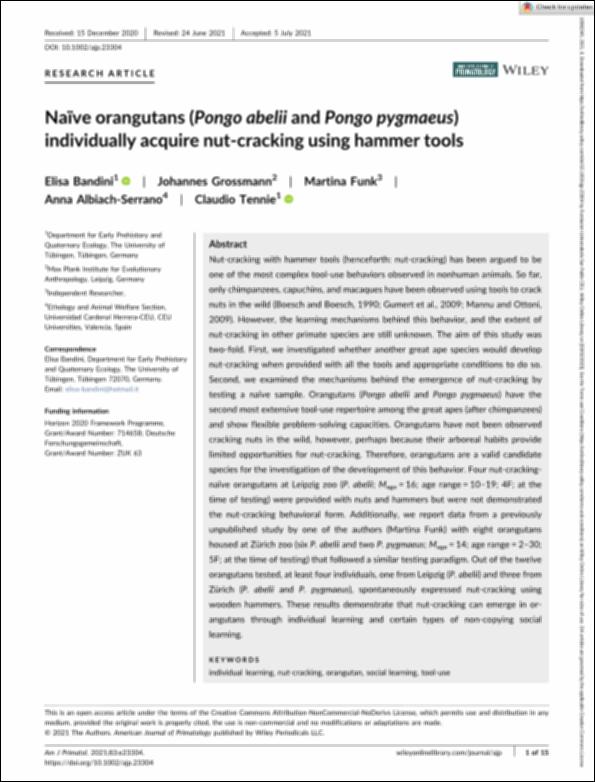Please use this identifier to cite or link to this item:
http://hdl.handle.net/10637/15365Naïve orangutans ("Pongo abelii" and "Pongo pygmaeus") individually acquire nut-cracking using hammer tools
| Title: | Naïve orangutans ("Pongo abelii" and "Pongo pygmaeus") individually acquire nut-cracking using hammer tools |
| Authors : | Bandini, Elisa Grossmann, Johannes Funk, Martina Albiach Serrano, Anna Tennie, Claudio |
| Keywords: | Comportamiento animal; Animal behaviour; Orangutanes; Orangutan; Aprendizaje animal; Learning in animals; Aprendizaje social; Social learning |
| Publisher: | John Wiley & Sons |
| Citation: | Bandini, E., Grossmann, J., Funk, M., Albiach-Serrano, A. & Tennie, C. (2021). Naïve orangutans ("Pongo abelii" and "Pongo pygmaeus") individually acquire nut-cracking using hammer tools. American Journal of Primatology, vol. 83, i. 9 (sep.), art. e23304. DOI: https://doi.org/10.1002/ajp.23304 |
| Abstract: | Nut-cracking with hammer tools (henceforth: nut-cracking) has been argued to be one of the most complex tool-use behaviors observed in nonhuman animals. So far, only chimpanzees, capuchins, and macaques have been observed using tools to crack nuts in the wild (Boesch and Boesch, 1990; Gumert et al., 2009; Mannu and Ottoni, 2009). However, the learning mechanisms behind this behavior, and the extent of nut-cracking in other primate species are still unknown. The aim of this study was two-fold. First, we investigated whether another great ape species would develop nut-cracking when provided with all the tools and appropriate conditions to do so. Second, we examined the mechanisms behind the emergence of nut-cracking by testing a naïve sample. Orangutans (Pongo abelii and Pongo pygmaeus) have the second most extensive tool-use repertoire among the great apes (after chimpanzees) and show flexible problem-solving capacities. Orangutans have not been observed cracking nuts in the wild, however, perhaps because their arboreal habits provide limited opportunities for nut-cracking. Therefore, orangutans are a valid candidate species for the investigation of the development of this behavior. Four nut-cracking-naïve orangutans at Leipzig zoo (P. abelii; Mage = 16; age range = 10–19; 4F; at the time of testing) were provided with nuts and hammers but were not demonstrated the nut-cracking behavioral form. Additionally, we report data from a previously unpublished study by one of the authors (Martina Funk) with eight orangutans housed at Zürich zoo (six P. abelii and two P. pygmaeus; Mage = 14; age range = 2–30; 5F; at the time of testing) that followed a similar testing paradigm. Out of the twelve orangutans tested, at least four individuals, one from Leipzig (P. abelii) and three from Zürich (P. abelii and P. pygmaeus), spontaneously expressed nut-cracking using wooden hammers. These results demonstrate that nut-cracking can emerge in orangutans through individual learning and certain types of non-copying social learning. |
| URI: | http://hdl.handle.net/10637/15365 |
| Rights : | http://creativecommons.org/licenses/by-nc-nd/4.0/deed.es Open Access |
| ISSN: | 0275-2565 1098-2345 (Electrónico) |
| Issue Date: | Sep-2021 |
| Center : | Universidad Cardenal Herrera-CEU |
| Appears in Collections: | Dpto. Producción y Sanidad Animal, Salud Pública Veterinaria y Ciencia y Tecnología de los Alimentos |
Items in DSpace are protected by copyright, with all rights reserved, unless otherwise indicated.


